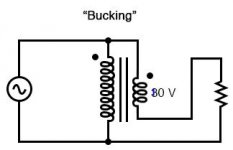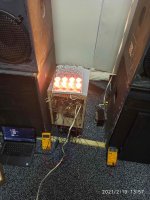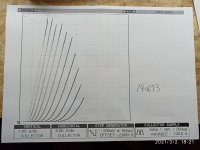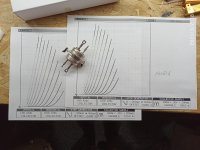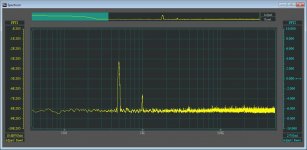I took a few steps back.
connected only the transformer to bridge and caps.
if the chassis is not connected, all good
if the chassis is connected trough thermistor (or directly), Depreciation relay of the hose is pop out.
Is a body of an electrolytic shorted to the chassis? Is the transformer shorted to the chassis? I suspect the latter; if you are using a toroid its easy to have the insulation pierced by accident.
Time to take a deep breath, stop, and make sure you're comfortable working with electricity before proceeding.
Start smaller if you need to, until you're comfortable wiring circuits together safely. We can't afford to lose a diyer. There are too few of us already. 🙂
Start smaller if you need to, until you're comfortable wiring circuits together safely. We can't afford to lose a diyer. There are too few of us already. 🙂
maybe is the transformer.
i don't know why, but the primary is connected to the secondary 😕
but still, it work.
Yipes Yipes Yipes Yipes
Now its obvious why your breaker box pops. Seriously, you need to take a step back and sort this out, starting with this connection.
No need for you to die of electric shock or a house fire!!
as diyer, i never give-up.
after watch this transformer, its “bucking” configuration, so the amplifier work only with float input, and i cannot connected the cap to ac line ground, because then the ac line ground is sort to natural.
so or o work with float input, or replace the transformer.
after watch this transformer, its “bucking” configuration, so the amplifier work only with float input, and i cannot connected the cap to ac line ground, because then the ac line ground is sort to natural.
so or o work with float input, or replace the transformer.
Attachments
Last edited:
I'm going with 'replace!!' since this arrangement is a serious shock hazard and will trip your breakers as soon as its connected to any other audio equipment!
Time to take a deep breath, stop, and make sure you're comfortable working with electricity before proceeding.
Start smaller if you need to, until you're comfortable wiring circuits together safely. We can't afford to lose a diyer. There are too few of us already. 🙂
i bought my house which was only equiped with several MCB distributor and it's cheap product. when i did my renovation, i changed all MCB to Schneider and add ELCB + surge arrester
with elcb 40mA rating, sometimes i tried to touch Live line and elcb tripped but not the mcb 🙂 now at least i can avoid any electric shock to my children, yeah previously my child put his pencil on socket wall and he got first electric shock
stay safe
Thank to everyone for the concern.
In the end the transformer structure was such that there was a common natural, this lesson cost me 200$ 🙂
I replaced the transformer to normal transformer with Independent secondary-primary, and the amplifier works (40v 3A)
In the end the transformer structure was such that there was a common natural, this lesson cost me 200$ 🙂
I replaced the transformer to normal transformer with Independent secondary-primary, and the amplifier works (40v 3A)
Attachments
Thank to everyone for the concern.
In the end the transformer structure was such that there was a common natural, this lesson cost me 200$ 🙂
I replaced the transformer to normal transformer with Independent secondary-primary, and the amplifier works (40v 3A)
good- Whew! 😉
take measurements with main set to -10dbfs
pull drain voltage to some 30V and try going up to 40V
set it to where you like it most
if you want more help, give us more details
pull drain voltage to some 30V and try going up to 40V
set it to where you like it most
if you want more help, give us more details
😕 Dumbo input: for those smashing fusez etc.
I saw in a amplifier by Nelson Pass/F3(?lovoltec design?) that he has a an electronic stabiliser on top: an IRF240, a 22k drop resistor and a cap to earth. So a slow ramp-up of the voltage.
Adding a zener across the G/S can limit the inrush extra at say 5 amp.
I liked it - thought it could be used too to overcome the problems of the unstabilized SIT at turn-on.
But maybe not useful in the l’amp. 🙄
I saw in a amplifier by Nelson Pass/F3(?lovoltec design?) that he has a an electronic stabiliser on top: an IRF240, a 22k drop resistor and a cap to earth. So a slow ramp-up of the voltage.
Adding a zener across the G/S can limit the inrush extra at say 5 amp.
I liked it - thought it could be used too to overcome the problems of the unstabilized SIT at turn-on.
But maybe not useful in the l’amp. 🙄
Last edited:
Smashing fuses on start-up is usually caused by the inrush current to the large capacitors after the rectifier. Thermistors in the primary of the power transformer can be used to control the inrush current on start-up.
Hi all,
any source for 300W 12V lamps? or better to go for choke?
Are there differences in result?
any source for 300W 12V lamps? or better to go for choke?
Are there differences in result?
@ Peppennino
The light bulb has a limited life span you can use 12R cheap high power wirewound resistors instead.
The light bulb has a limited life span you can use 12R cheap high power wirewound resistors instead.
Hi all,
any source for 300W 12V lamps? or better to go for choke?
Are there differences in result?
You mean 110-120V. Yes you can find them even on ebay from China. You can use not simple but other types of lamps. However, at least to my ears, better go with inductor. I used to go with 195T5 but then switched to custom made at local shop. They created 100 mH/8A with about 70 euros.
- Home
- Amplifiers
- Pass Labs
- L'Amp: A simple SIT Amp

